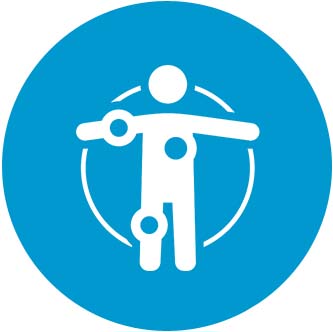Hip Specialists – Top DC Hip Physical Therapists
Hip Physical Therapy Treatment
Hands-On Techniques. Long-Term Effective Hip Pain Relief
Hip Pain Relief
Hip pain is commonly experienced by many people in the United States. The hip joint is unique in that it’s almost always being put to use making the hip joint is the second most commonly affected large joint in the body. The size and the mechanical complexity of the hip joint makes it more prone to injury. Many painful conditions can affect the hip itself or the ligaments or muscles surrounding the joint.
With hip pain, it’s important to determine whether the pain is the result of an sudden injury or a long-term condition of the joint. Pain could be due to physical injuries, mechanical problems, or a type of musculoskeletal condition. Your age, previous injuries, and types of physical activities you engage in all affect your risk for hip pain. In the United States, 7% of all adults report pain related to having hip pain. With adults aged 65 or older, about double the amount (15%) report having hip pain throughout the day.
 Signs & Symptoms
Signs & Symptoms
-
A sudden pain in the hip is usually the result of a direct physical injury to the hip. Falling or abnormal twisting the hip, among other injuries, can cause intense pain, bruising, or swelling. Long-term pain of the hip usually develops because of overuse with repetitive or demanding movements as well as past trauma to the joint. Any hip pain is considered chronic if it has been present for over 2 or 3 months.
- Inability to put weight on the hip
- Inability to move the hip in a normal manner
- Constant ache
- Sharp pain or stiffness when moving the joint
- Dull burning sensation
- Chronic swelling or pain when hip is touched
Common symptoms of hip pain include:
 Why PT?
Why PT?
-
Whatever the cause of your pain, using physical therapy as part of your treatment can have a dramatic affect on your long-term recovery. Physical therapy is proven reduce the need for surgery in patients, decrease pain, and improve mobility in pre- and post-surgery patients. Both manual therapy and guided exercise should be used for the best treatment outcomes. Patients with hip osteoarthritis who receive manual therapy along with their treatment program have better improvements with pain, stiffness, motion, and function.
- Manual, hands-on therapy to increase mobility and tissue healing for irritated structures around the hip which are preventing proper movement.
- Joint mobilization are performed manually on specific muscles and the hip to restore the full range of their movements (i.e. hip flexion and external/internal rotation of the hip).
- Custom exercise program to strengthen the muscles that support and protect the hip to increase functional movement and decrease risk of further injury.